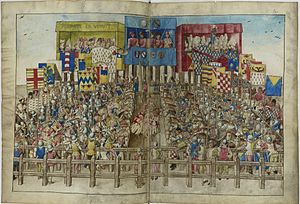
Heraldry is the system of visual identification of rank and pedigree which developed in the European High Middle Ages,[2] closely associated with the courtly culture of chivalry, Latin Christianity, the Crusades, feudal aristocracy, and monarchy of the time. Heraldic tradition fully developed in the 13th century, and it flourished and developed further during the Late Middle Ages and the Early Modern period. Originally limited to nobility, heraldry is adopted by wealthy commoners in the Late Middle Ages (Burgher arms). Specific traditions of Ecclesiastical heraldry also develop in the late medieval period. Coats of arms of noble families, often after their extinction, becomes attached to the territories they used to own, giving rise to municipal coats of arms by the 16th century.
Western heraldry spread beyond its core territory of Latin Christendom in the 17th century, Western heraldic traditions being adopted in the Russian Empire. With colonialism, the use of heraldry has spread to other continents, e.g. Africa and the Americas.
While some concepts associated with heraldry, such as nobility and monarchy, have declined in favour of Republicanism in the 19th to 20th centuries, heraldry as a whole continues to flourish, with the art form today enjoying greater prevalence than ever in countries with strong heraldic traditions.[3] Even elsewhere, elements inherited from heraldic tradition are frequently used in national flags and emblems around the world.
- ^ Octave Delepierre, Précis des annales de Bruges (1835) 38f. René of Anjou's contemporary Louis de Gruuthuse himself was a famous competitor in tournaments during the 1440s.
- ^ Fox-Davies, A Complete Guide to Heraldry, pp. 1–18.
- ^ Klackenberg, Henrik (2002), Heraldiken i folkhemmet (in Swedish), p. 6
© MMXXIII Rich X Search. We shall prevail. All rights reserved. Rich X Search
